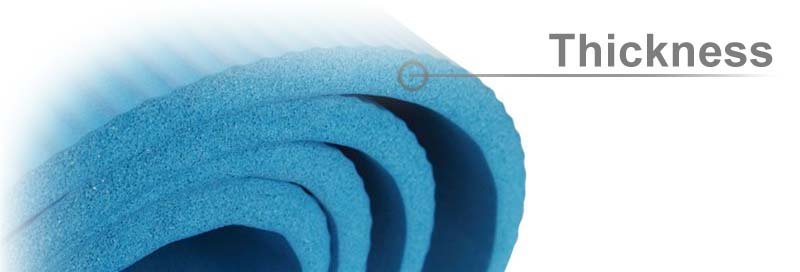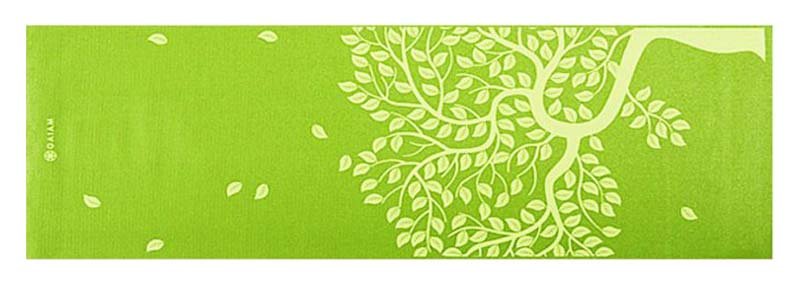Nowadays, more people are trying other forms of relaxation and exercise. For most people, especially those who are working for eight hours a day, a simple workout that consists of weights and cardio/aerobics just won’t do. This is why people are looking for more fresh ways to stay fit and relax at the same time, with yoga mats. Some prefer pilates, while others enjoy classic yoga.
Yoga is a special Hindu discipline that combines breathing control, meditation, improvement of body posture, relaxation, and simple exercise. Most of its famous moves are usually done while lying down or sitting on the floor, so without really analyzing it, a good and sturdy yoga mat is important in every session. Without a mat to support the body, there is no way that the person practicing yoga will be comfortable and successful in relaxing.
So, what makes a reliable and trusty yoga mat? Read on and learn more about yoga mats.

Introducing Yoga Mats
For a yogi or someone who practices yoga, a mat is very, very important. In a way, it serves as a symbol of their own personal space.
But for people who have never even done a single yoga position, here is a quick introduction to yoga mats:
A yoga mat is a yogi’s best friend in every yoga session. It is a fabricated mat that helps in supporting the yogi with every move he/she makes. Also called non-slip mats or sticky mats, these yoga mats aid the user and prevent their hands and feet from slipping during a difficult yoga position.
Basically, that is all there is to know about yoga mats. However, if you want to learn more, feel free to keep reading.
Yoga Mat’s Humble Beginnings
Yoga mats did not just spring out somewhere, and even though the practice of doing yoga started long ago, the invention of yoga mats did not begin until the 1960s.

Angela Farmer, a world-renowned yoga instructor, was responsible for probably creating the yoga mats as we know them today. In 1968, while teaching yoga in Munich, she came across a piece of carpet underlay and used it during her practice. Upon returning to London, the material she discovered became very famous with her students.
Thus, the world’s first yoga mat was born.
Characteristics of Yoga Mats
Not all yoga mats are the same.
7 Main Characteristics of Yoga Mats
Yoga mats possess six primary characteristics that influence their performance and suitability for practitioners. These characteristics include dimensions, material, тhickness, texture, stickiness, weight, and aesthetics. Understanding these key features is essential for selecting the most appropriate yoga mat based on individual preferences, practice needs, and lifestyle considerations.
Dimensions
The dimensions of a yoga mat refer to its length and width, which play a crucial role in providing adequate space for yoga practice. Standard yoga mats typically measure around 182 centimeters (72 inches) in length and 60 centimeters (24 inches) in width. However, there are variations available, including longer and wider mats for taller individuals or those who prefer more space during practice.
The dimensions of a yoga mat are essential for ensuring comfort and stability during poses, as they determine the amount of surface area available for movement and support. Additionally, choosing the right-sized mat can help accommodate different body shapes and sizes, allowing practitioners to fully engage in their practice without feeling restricted or cramped.
Material
When selecting a yoga mat, the material is a critical factor to consider as it directly impacts your practice experience. Yoga mats are crafted from a variety of materials, each offering unique qualities and benefits. PVC mats are durable and provide excellent grip, making them ideal for vigorous practices. Natural jute and rubber mats offer eco-friendly options with good traction and cushioning. Thermoplastic elastomer mats offer a balance of durability and comfort, while bamboo mats are sustainable choices for outdoor use.
Understanding the material composition of your yoga mat is essential for assessing its suitability for your practice. Different materials offer varying levels of traction, cushioning, and durability, allowing you to find the perfect mat to support your yoga journey. Consider your priorities, such as sustainability, grip, and comfort, when choosing between PVC, rubber, jute, or alternative materials. By selecting a mat that aligns with your needs and preferences, you can enhance your practice and enjoy greater comfort and support over time.
Thickness
As for the thickness, yoga mats can be 2 millimeters (lightweight), 4-5 millimeters (standard), or 7 millimeters thick— it all depends on your needs and the intensity of yoga that you are practicing.
The thickness of your yoga mat is very important, especially with certain yoga positions. For example, if it is too thin, then your knee might get uncomfortable during the crescent lunge. However, if it is too thick, doing the Tree Pose can be quite difficult for you.

It is important to think about your comfort when it comes to picking the right yoga mat. However, it is also crucial to ponder about the mat’s portability and your personal practice space. Do not buy a yoga mat that will not fit in, for example, your room, and do consider the fact that you have the tendency to bring it somewhere, so think about how easily it will roll and fit in your bag.
Texture
Knowing the texture of your potential yoga mat can help you determine how much traction it has. It is as important as the stickiness of the mat because the texture also affects your performance while doing yoga. If the texture is just right, it can help prevent any slipping and sliding, especially when executing difficult poses.
Stickness
Yoga consists of various poses that might include bending and testing your flexibility. A sticky yoga mat can aid you in these positions because it prevents you from slipping, sliding, and falling all over the place. For a good sticky yoga mat, it is best to purchase a PVC yoga mat, which has the highest sticky factor out of all types of mats.
Weight
Weight is a crucial aspect to consider when selecting a yoga mat, as it directly impacts portability and convenience. Yoga mats vary in weight depending on their thickness, size, and material composition.
Lightweight mats are ideal for practitioners who travel frequently or attend yoga classes outside the home, as they are easy to carry and transport. They provide the flexibility to practice yoga wherever you go without feeling burdened by a heavy mat.
On the other hand, heavier mats offer greater stability and durability, making them suitable for home practice or studio use where portability is less of a concern.
When choosing a yoga mat based on weight, consider your lifestyle and practice preferences. If you prioritize mobility and versatility, opt for a lightweight mat that you can easily carry with you. However, if stability and longevity are your main concerns, a heavier mat may be the better choice for providing a solid foundation during your yoga practice.
Ultimately, finding the right balance between weight and functionality will ensure that your yoga mat enhances rather than hinders your practice experience.
Aesthetics

Yoga mats also vary in appearance. When looking for the right mat, you can choose from a variety of colors, designs, patterns, and even custom logos. For example, there are “alignment mats,” which are printed with special guides to help users when it comes to proper alignment.
Things to Consider When Buying Yoga Mats
So, are you ready to embark on a new journey to the yoga world? Do not go without the necessary stuff: discipline… and a yoga mat.
Finding the right yoga mat is not always easy. There are lots of options out there, and at first, it can get a little tricky. What if the one that you find is not really the right aid?
Do not fret – here are some of the things you need to consider when buying the perfect yoga mat:
In conclusion, investing in the best yoga mat for your practice is essential for comfort, stability, and safety. With the increasing popularity of yoga and its numerous benefits for physical and mental well-being, having a reliable yoga mat is more important than ever. Whether you prefer traditional yoga, hot yoga, or pilates, a high-quality yoga mat can enhance your practice and elevate your experience. Consider factors such as thickness, stickiness, material, and texture when choosing the right yoga mat for you. By prioritizing comfort and performance, you can ensure a fulfilling and enjoyable yoga practice for years to come.





